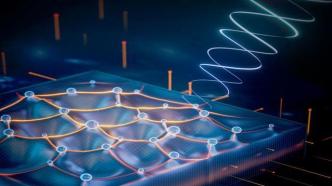

Simulated holographic wormhole. Caltech map
The situation of quantum physics and general relativity "looking at each other and hating each other" is almost recognized by the theoretical physics community, but quantum gravity is trying to "reconcile" the two. A paper published in the British journal Nature reports for the first time the quantum "simulation" of holographic wormholes using a quantum processor. The demonstration, using Google's Sycamore processor, represents a step closer to studying quantum gravity in the lab.
General relativity describes the high-energy or high-matter-density physical world, such as astrophysical objects; quantum mechanics describes matter at the atomic and subatomic level. Quantum gravity is a hypothetical theory of physics that describes objects that are relevant in both cases, such as the interiors of black holes, which have so far been impossible to peer into.
However, quantum mechanics and general relativity are fundamentally incompatible. Arguably one of the deepest problems in theoretical physics today is reconciling general relativity and quantum mechanics. Therefore, the scientific community has not yet reached a consensus on the theory of quantum gravity.
The holographic principle is considered a way of connecting different theories, and the theory may have the potential to help reconcile quantum mechanics with general relativity, which interprets relativity as an extension of quantum physics, using a constrained physical system.
According to the principle of holography, scientists Maria Spiroplu, Hortney Calvin and their colleagues at the California Institute of Technology designed a simple system to simulate a holographic wormhole. Here, the properties of a properly designed quantum system also match those of a gravitational system.
The quantum simulations were performed using a quantum computer with a 9-qubit circuit. The dynamics of a qubit traveling through this processor are the same as those of a qubit traveling through a traversable wormhole.
In an accompanying News & Views article, Stanford University scientist Adam Brown said the experiment was the first to demonstrate the potential feasibility of using quantum computers to test the theory of quantum gravity in the future.
[The editor-in-chief circles]
Simply put, "Mr. General Relativity" describes gravity and is applicable on large scales such as stars, planets, and galaxies; while "Miss Quantum Mechanics" describes the other three fundamental forces acting on microscopic scales. Is it possible for the two to "shake hands and say goodbye"? It also depends on the performance of quantum gravity. Physicists certainly want to test it through experiments, but unfortunately, the energy and scale of quantum gravity cannot be simulated and observed under previous laboratory conditions. Perhaps looking back many years later, today's achievement is a milestone, and it may be the beginning of solving large-mass energy and small-scale space at the same time in the future, such as the behavior of black holes, such as the origin of the universe.
(Original title "Helping Quantum Gravity "Reconcile" the Biggest Contradiction in the Field of Modern Physics Humans Use Quantum Computers to Simulate Holographic Wormholes for the First Time")

